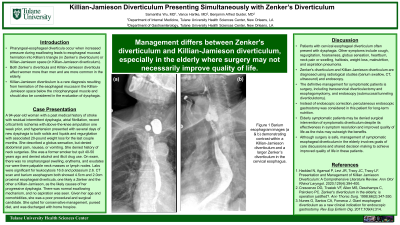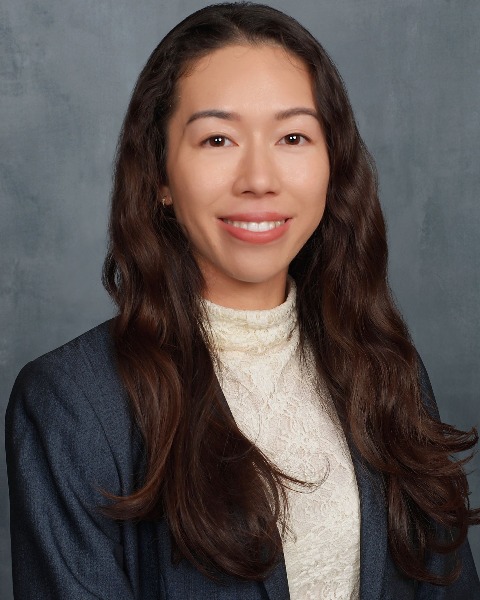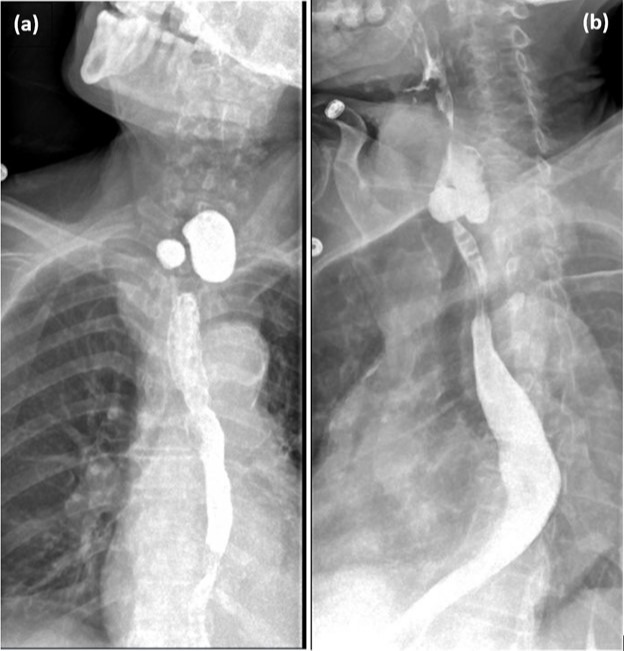Sunday Poster Session
Category: Esophagus
P0517 - Killian-Jamieson Diverticulum Presenting Simultaneously With Zenker’s Diverticulum
Sunday, October 22, 2023
3:30 PM - 7:00 PM PT
Location: Exhibit Hall

Has Audio

Samantha Wu, MD
Tulane Medical Center
New Orleans, LA
Presenting Author(s)
Samantha Wu, MD1, Vance Hartke, MD1, Benjamin A. Guider, MD2
1Tulane Medical Center, New Orleans, LA; 2Tulane University School of Medicine, New Orleans, LA
Introduction: Pharyngeal-esophageal diverticula occur when increased pressure during swallowing leads to esophageal mucosal herniation into Killian’s triangle (in Zenker’s diverticulum, ZD) or Killian-Jamieson space below the cricopharyngeal muscle (in Killian-Jamieson diverticulum, KJD). Patients with cervical esophageal diverticulum often present with dysphagia. Other symptoms include cough, regurgitation, hoarseness, globus sensation, heartburn, neck pain or swelling, halitosis, weight loss, malnutrition, and aspiration pneumonia. Both ZD and KJD affect women more than men and are more common in the elderly.
Case Description/Methods: A 94-year-old woman with a past medical history of stroke with residual intermittent dysphagia, atrial fibrillation, hypertension, and recent critical limb ischemia with above-the-knee amputation one week prior presented with several days of new dysphagia to both solids and liquids and regurgitation and 20-pound weight loss for the last couple months. She described a globus sensation, but denied abdominal pain, nausea, or vomiting. She denied history of neck surgeries. She was a former smoker but quit 40-50 years ago and denied alcohol and illicit drug use. There was no oropharyngeal swelling, erythema, and exudates nor were there palpable neck masses on exam. Computerized tomography (CT) scan and barium esophagram both showed 4.5cm and 2.0cm proximal esophageal diverticula, one likely a ZD and the other a KJD, as the likely causes of her progressive dysphagia (Figure 1). There was normal swallowing mechanism, and no aspiration was seen. Given her age and comorbidities, she opted for conservative management, pureed diet, and was discharged with home hospice.
Discussion: KJD is a rare diagnosis which makes it an important consideration in the evaluation of dysphagia. Simultaneously occurring ZD and KJD have only been described twice in the literature. They are diagnosed using radiological studies (barium swallow, CT, ultrasound). Management for symptomatic patients is traditionally surgery, including transcervical diverticulectomy or diverticulopexy with or without cricopharyngeal and esophagomyotomy, however, endoscopic approaches such as transmural septum division and per-oral endoscopic myotomy have also been safe and effective. Elderly patients may be denied surgical intervention if the risks outweigh the benefits. Management of symptomatic esophageal diverticulum in the elderly involves goals of care discussions to achieve improved quality of life in these patients.

Disclosures:
Samantha Wu, MD1, Vance Hartke, MD1, Benjamin A. Guider, MD2. P0517 - Killian-Jamieson Diverticulum Presenting Simultaneously With Zenker’s Diverticulum, ACG 2023 Annual Scientific Meeting Abstracts. Vancouver, BC, Canada: American College of Gastroenterology.
1Tulane Medical Center, New Orleans, LA; 2Tulane University School of Medicine, New Orleans, LA
Introduction: Pharyngeal-esophageal diverticula occur when increased pressure during swallowing leads to esophageal mucosal herniation into Killian’s triangle (in Zenker’s diverticulum, ZD) or Killian-Jamieson space below the cricopharyngeal muscle (in Killian-Jamieson diverticulum, KJD). Patients with cervical esophageal diverticulum often present with dysphagia. Other symptoms include cough, regurgitation, hoarseness, globus sensation, heartburn, neck pain or swelling, halitosis, weight loss, malnutrition, and aspiration pneumonia. Both ZD and KJD affect women more than men and are more common in the elderly.
Case Description/Methods: A 94-year-old woman with a past medical history of stroke with residual intermittent dysphagia, atrial fibrillation, hypertension, and recent critical limb ischemia with above-the-knee amputation one week prior presented with several days of new dysphagia to both solids and liquids and regurgitation and 20-pound weight loss for the last couple months. She described a globus sensation, but denied abdominal pain, nausea, or vomiting. She denied history of neck surgeries. She was a former smoker but quit 40-50 years ago and denied alcohol and illicit drug use. There was no oropharyngeal swelling, erythema, and exudates nor were there palpable neck masses on exam. Computerized tomography (CT) scan and barium esophagram both showed 4.5cm and 2.0cm proximal esophageal diverticula, one likely a ZD and the other a KJD, as the likely causes of her progressive dysphagia (Figure 1). There was normal swallowing mechanism, and no aspiration was seen. Given her age and comorbidities, she opted for conservative management, pureed diet, and was discharged with home hospice.
Discussion: KJD is a rare diagnosis which makes it an important consideration in the evaluation of dysphagia. Simultaneously occurring ZD and KJD have only been described twice in the literature. They are diagnosed using radiological studies (barium swallow, CT, ultrasound). Management for symptomatic patients is traditionally surgery, including transcervical diverticulectomy or diverticulopexy with or without cricopharyngeal and esophagomyotomy, however, endoscopic approaches such as transmural septum division and per-oral endoscopic myotomy have also been safe and effective. Elderly patients may be denied surgical intervention if the risks outweigh the benefits. Management of symptomatic esophageal diverticulum in the elderly involves goals of care discussions to achieve improved quality of life in these patients.

Figure: Barium esophagram images (a & b) demonstrating contrast within a Killian-Jamieson diverticulum and a larger Zenker’s diverticulum in the cervical esophagus.
Disclosures:
Samantha Wu indicated no relevant financial relationships.
Vance Hartke indicated no relevant financial relationships.
Benjamin Guider indicated no relevant financial relationships.
Samantha Wu, MD1, Vance Hartke, MD1, Benjamin A. Guider, MD2. P0517 - Killian-Jamieson Diverticulum Presenting Simultaneously With Zenker’s Diverticulum, ACG 2023 Annual Scientific Meeting Abstracts. Vancouver, BC, Canada: American College of Gastroenterology.
